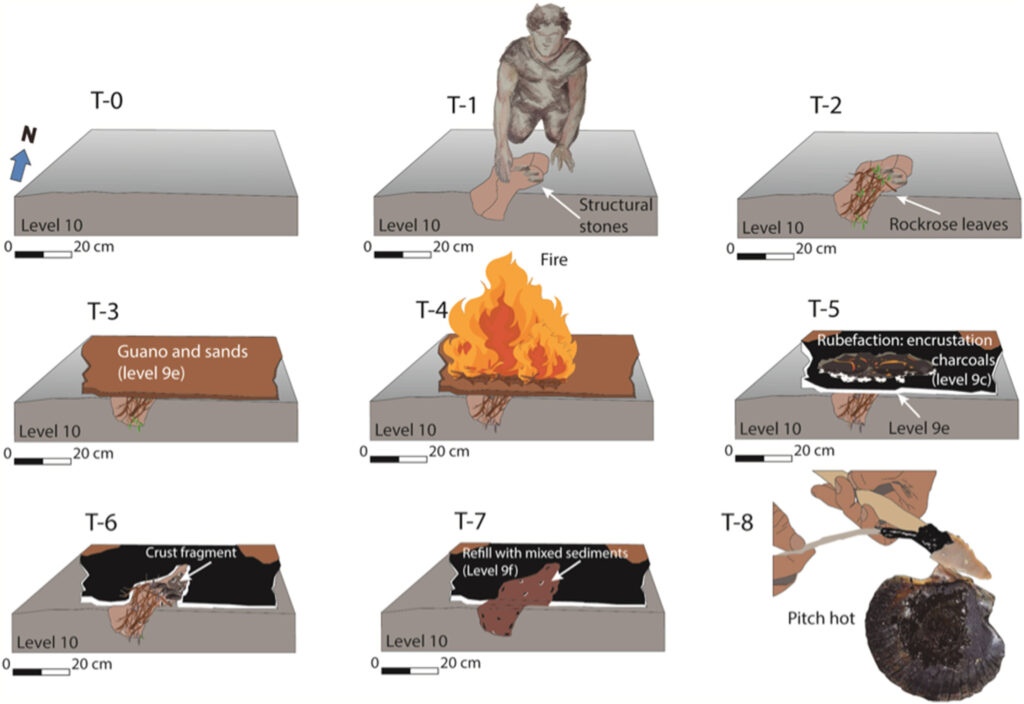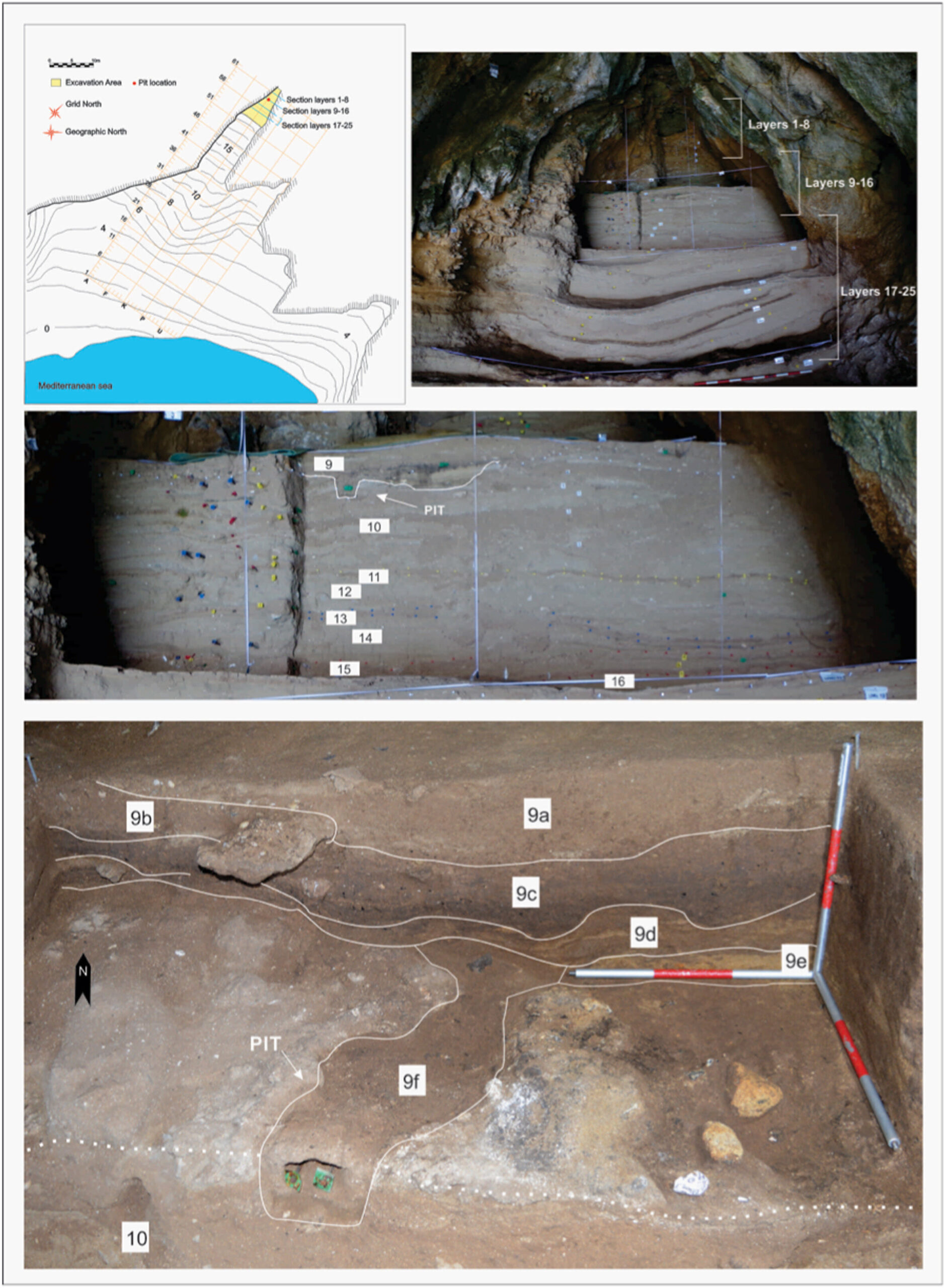Hidden in the rugged cliffs of Gibraltar, overlooking the serene Alboran Sea, lies a remarkable window into the distant past—an ancient Neanderthal-built tar distillation oven that remained concealed for 65,000 years. The discovery, led by the University of Murcia, takes us back to a time when our distant ancestors harnessed fire not only for warmth and cooking but also for the sophisticated task of creating tar from plants—a critical advancement in their tool-making technologies.
Vanguard Cave, a site rich with archaeological potential, has revealed a sophisticated Neanderthal hearth structure. The newly discovered remnants of this ancient hearth, combined with Middle Paleolithic stone tools and residues, provide compelling evidence that Neanderthals at this location were manufacturing tar from rockrose plants (Cistaceae), demonstrating their advanced knowledge of fire management and technology. This tar was not a mere byproduct of their activities but an essential element used for hafting stone tools to wooden handles—an innovation that predates the modern human use of tar adhesives by more than 100,000 years.
A Glimpse into Neanderthal Ingenuity
For decades, researchers have theorized that Neanderthals were capable of extracting tar from plant materials using underground fire pits. However, direct evidence supporting this theory had been elusive, leaving much to the imagination. The new study, titled A Neanderthal’s Specialized Burning Structure Compatible with Tar Obtention, published in Quaternary Science Reviews, offers the first tangible proof of such specialized fire-pit structures.
The research team, employing a variety of scientific methods—including geochemical, mineralogical, palynological, and micromorphological analyses—revealed a unique hearth pit in Vanguard Cave. This structure was no ordinary fire pit. It contained a central fire zone flanked by two opposite-sided trenches, and the surrounding rocks and sediments were altered by prolonged exposure to intense heat, confirming that this was a site for repeated, specialized use of fire.
This hearth structure’s design is consistent with what theorists had predicted: it created a low-oxygen environment conducive to the distillation process required for tar extraction. The goal of such an arrangement is to facilitate the controlled burning of plant materials at temperatures that would release resin without completely combusting the organic matter.
The Complex Chemistry Behind Tar Production
The geochemical analysis conducted on the sediments and residues of the hearth revealed striking results. Among the compounds identified were levoglucosan and retene, both of which are markers of combustion processes involving resinous plants—such as rockrose. This confirmed that Neanderthals were indeed using fire to distill tar from these plants.
Further lipid analysis revealed interesting biomarkers: straight-chain n-alkanes of odd carbon numbers and n-alkanols of even carbon numbers. These are characteristic of the fresh leaf wax of plants like rockrose, further supporting the hypothesis that Neanderthals deliberately introduced plant materials into the fire to extract tar. This level of intentionality and precision in managing plant materials for a specific purpose—creating tar—is a clear indicator of Neanderthal cognitive complexity.
Perhaps most striking of all were the results from the charcoal analysis. The study found that less than 10% of the charcoal residue came from coniferous wood, a material typically associated with high-temperature fires. Instead, most of the charcoal came from plants in the rockrose family, showing evidence of incomplete combustion under controlled conditions. This aligns perfectly with the notion that Neanderthals were actively managing fire to achieve specific temperatures for tar production, rather than simply allowing a fire to burn out of control.
Microscopic Clues and Deliberate Fire Management
The palynological analysis of the hearth structure provided yet more evidence of Neanderthal sophistication. A dense concentration of pollen grains was found within the hearth’s matrix, while surrounding sediments were completely devoid of pollen. This suggests that Neanderthals intentionally added plant material to the fire to achieve the desired chemical outcomes.
Micromorphological analysis also played a key role in confirming the controlled nature of the heating process. No evidence was found of heating above 500°C, a temperature consistent with tar distillation but well below the threshold for other high-temperature processes like pottery firing. This low-temperature condition is vital for the distillation process, where organic compounds are broken down and transformed into tar without burning up the plant material entirely.
In addition, the team found carbonate rocks within the structure, which appeared to have been carefully placed. These rocks likely acted as a sealant, maintaining an optimal low-oxygen environment for the tar extraction process. The use of guano and sand as part of this sealing material further highlights the sophisticated and resourceful nature of Neanderthal fire management.
Recreating History: Experimental Archaeology
To test their hypothesis, the researchers engaged in experimental archaeology—reconstructing a similar hearth structure and attempting to replicate the tar extraction process. Using only materials and tools that would have been available to Neanderthals, the team successfully created a substance suitable for hafting stone spearheads. The experiment not only confirmed the viability of the process but also demonstrated the practical applications of Neanderthal technology, which were crucial for their survival and tool-making capabilities.

The successful reconstruction of a Neanderthal tar distillation oven is more than just a scientific achievement; it’s a profound insight into the cognitive and cultural development of our ancient relatives. The ability to produce tar would have been instrumental in creating tools that were more effective and versatile—giving Neanderthals a significant advantage in their environment.
The Cognitive Leap of Neanderthals
The evidence from Vanguard Cave underscores a vital point: Neanderthals were far more advanced than previously thought. The discovery of a dedicated, specialized hearth for tar extraction shows that Neanderthals were not just primitive tool-users, but also early innovators who understood and controlled their environment in sophisticated ways.
This revelation challenges the outdated view of Neanderthals as simple, brute creatures. Instead, it paints a picture of Neanderthals as complex, thoughtful beings capable of planning and executing intricate tasks. Their ability to manipulate fire for specialized purposes—such as tar production—shows a depth of cognitive and technological development that parallels, in some ways, that of early modern humans.
The construction of a complex fire-related structure for tar extraction suggests that Neanderthals not only had the tools and techniques to craft stone tools but also possessed the foresight to create a sustainable method for enhancing the quality and functionality of those tools. This level of sophistication, based on direct evidence from the archaeological record, is a powerful reminder of how much we still have to learn about the lives of these fascinating humans.
Conclusion: A New Chapter in Neanderthal History
The discovery of the tar distillation oven in Vanguard Cave represents a significant breakthrough in our understanding of Neanderthal behavior, technology, and culture. It shifts the narrative from one of simple survival to one of complex innovation and sophisticated craftsmanship. Neanderthals were not just survivors; they were, in many ways, pioneers who laid the groundwork for the technological advancements that would eventually define modern humans.
By harnessing fire for the specialized purpose of tar extraction, Neanderthals demonstrated a level of ingenuity and problem-solving that challenges the conventional wisdom about their cognitive capabilities. The evidence found in Vanguard Cave is a testament to the rich and intricate ways in which Neanderthals engaged with their environment, a legacy that continues to shape our understanding of human evolution.
Reference: Juan Ochando et al, A Neanderthal’s specialised burning structure compatible with tar obtention, Quaternary Science Reviews (2024). DOI: 10.1016/j.quascirev.2024.109025
